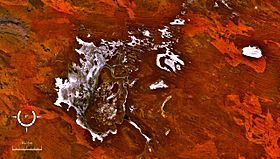Kumpupintil Lake facts for kids
Quick facts for kids Lake Disappointment |
|
|---|---|

Landsat image; screen capture from NASA World Wind
|
|
 |
|
| Location | Western Australia |
| Coordinates | 23°30′S 122°50′E / 23.500°S 122.833°E |
| Lake type | Endorheic salt lake |
| Native name | Kumpupintil (Martu) |
| Basin countries | Australia |
| Max. length | 160 km (99 mi) |
| Surface area | 330 km2 (130 sq mi) |
| Surface elevation | 325 metres (1,066 ft) |
Kumpupintil Lake (pronounced goom-bu-pin-dil) is a special type of salt lake in Western Australia. It was once known as Lake Disappointment. This lake is found in the Little Sandy Desert, which is east of the Pilbara region.
Contents
About Kumpupintil Lake
Kumpupintil Lake is about 160 kilometres (100 miles) long. It is located about 300 kilometres (186 miles) east of a town called Newman.
This lake is usually dry. It only fills up with water during very wet times. For example, it filled during the 1900 Western Australian floods and in many recent tropical wet seasons since 1967.
The lake is located on the Tropic of Capricorn. It is east of the mining town of Newman and the Jigalong Community. The lake is on the northern side of the Little Sandy Desert. It is also south of the Karlamilyi National Park.
The area around the lake has many sand dunes. The Canning Stock Route passes along the western side of the lake. The lake's elevation is 325 metres (1,066 feet) above sea level.
Importance to People and Wildlife
Kumpupintil Lake is very important to the Martu people. They are the traditional owners of this land. The lake holds deep spiritual and ceremonial meaning for them. It is also a vital place for finding water and traditional food.
The lake is home to many different kinds of water birds. In 2007, scientists found a new species of dragon lizard here. They named it Ctenophorus nguyarna.
Martu Mythology and Spirits
In the culture of the Aboriginal people, Kumpupintil Lake was a forbidden place. Tribes like the Kurajarra, Wanman, Kartudjara, and Putidjara were not allowed to go there. This rule still exists today.
The reason for this rule comes from old stories. These stories say that Ngayurnangalku spirits live under the lake's surface. These spirits are ancestral beings. They are described as having pointy teeth and claw-like fingernails.
The stories say these spirits can even attack planes flying over the lake. Because of this, flying over the area was also forbidden.
Aboriginal people tell a story about the Ngayurnangalku spirits. They say the spirits split into 'good' and 'bad' groups. They argued about whether to keep eating people. One group decided to stop. They were protected by 'bodyguards'. The other group continued to eat people.
Aboriginal stockmen would muffle their horses' bells. This was to avoid making noise. They did not want to alert the cannibals when they came near the lake.
How the Lake Got its Names
The lake was first named Lake Disappointment by an explorer named Frank Hann in 1897. Hann was exploring the eastern Pilbara region. He saw creeks flowing inland. He followed them, hoping to find a large fresh water lake.
However, the lake was usually dry. Because he was disappointed, he named it Lake Disappointment.
On November 11, 2020, the Western Australian Government officially approved a new name. The lake is now formally called Kumpupintil Lake. This change happened after a request from the traditional owners and the Western Desert Lands Aboriginal Corporation.
The name "Kumpupintil" tells the story of how the lake was formed. It is part of a Martu creation story. In this story, Martu warriors fought powerful giants in a big battle.
Images for kids
See also
 In Spanish: Lago Disappointment para niños
In Spanish: Lago Disappointment para niños



